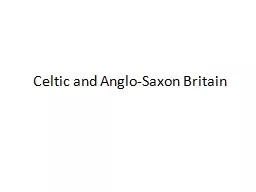

and AngloSaxon Britain Vocabulary building Find in the section the relevant words for each heading Be ready to give their Italian equivalent ID: 449468
Download Presentation The PPT/PDF document "Celtic" is the property of its rightful owner. Permission is granted to download and print the materials on this web site for personal, non-commercial use only, and to display it on your personal computer provided you do not modify the materials and that you retain all copyright notices contained in the materials. By downloading content from our website, you accept the terms of this agreement.
Slide1
Celtic
and
Anglo-Saxon
BritainSlide2
Vocabulary
buildingFind in the section the relevant words for each heading. Be ready to give their Italian equivalent.
ArchitectureMonumentTempleWallCities/townsRoad systems
GeographyBritainScotlandIreland GermanyJutlandWalesEnglandNorth (of England)MidlandsDanelaw
PeopleBritonsPre-celtic peopleCeltic tribesRomansAnglesSaxonsJutesAnglo-SaxonsGreeksVikingsDanish
Military
expeditions
Conquest
Emperor
Control
Province
Invade
Fight
Invaders
Leader
King
Empire
Warlike
kinglySlide3
Study
questionsWho were the original inhabitants of Britain?The Celts were the original inhabitants of the island.What traces of pre-Celtic presence can we still find?Stonehenge, a religious monument made of a circle of monolithic stones is the best example of pre-Celtic civilizationWhen did Julius Caesar invade Britain?In 55 B.C., when his legions started the colonization of the island.Who began the Roman conquest? When?Emperor Claudius began the conquest in 43 A.D.
How did the Romans fortify their northern border?By building a huge wall at the border between modern England andScotland which is known as Hadrian’s Wall after the name of the emperorwho planned it.When was Christianity introduced into Britain?The Celtic tribes became Christian in the fourth century.Slide4
What still testifies to the Roman presence in Britain?
The names of some towns ending in –chester and –cester from the latinword “castra”, as well as the old road systems and the foundations ofsome of today’s major cities, including London.When did the Anglo-Saxon invasion begin?It began in 449 A.D. after the withdrawal of the Roman forces in 410 A.D.Who were the new settlers and where did they come from?
The Angles, the Saxons and the Jutes.they were northern tribes who camefrom northern Germany and the Jutland peninsula.What happened to the original inhabitants of the land, the Celts? Who was King Arthur?The Celts had to retreat to the inner parts of Wales where their languageis still spoken nowadays. King Arthur was a legendary Celtic king. Thestories about him would later become the inspiration for much literarymaterial.Slide5
How would you describe the Germanic element in the life of England’s new settlers?
They all shared a common Germanic heritage. They were all warlike tribesand shared the ideal of a kingly behaviour.Name some of the small Anglo-Saxon kingdoms.Northumbria, Mercia, Kent and WessexWhich invasions did the Anglo-Saxons have to face?They had to fight against the Vikings,who started to invade in about 800A.D. The Anglo-Saxon king Alfred the Great (871 -901) fought them but
then had to divide England with them.How far did Canute’s kingdom stretch?The Danish king Canute (1016-1035) conquered and reigned not only overall of England but also over the Viking homelands (Denmark, Norway andpartof Sweden).